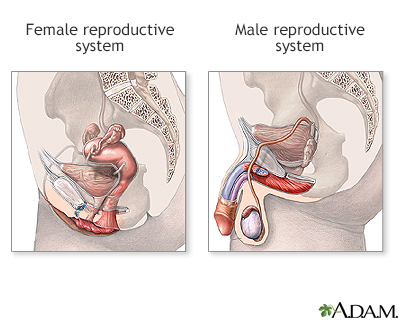Chancroid
Soft chancre; Ulcus molle; Sexually transmitted disease - chancroid; STD - chancroid; Sexually transmitted infection - chancroid; STI - chancroid
Chancroid is a bacterial infection that is spread through sexual contact.
Images

Causes
Chancroid is caused by a bacterium called Haemophilus ducreyi.
The infection is found in many parts of the world, such as Africa and southwest Asia. The infection is uncommon in the United States. Most people in the United States who are diagnosed with chancroid get it outside the country in areas where the infection is more common.
Symptoms
Within 1 day to 2 weeks after becoming infected, a person will get a small bump on the genitals. The bump becomes an ulcer within a day after it first appears. The ulcer:
- Ranges in size from 1/8 inch to 2 inches (3 millimeters to 5 centimeters) in diameter
- Is painful
- Is soft
- Has sharply defined borders
- Has a base that is covered with a gray or yellowish-gray material
- Has a base that bleeds easily if it is bumped or scraped
About one half of infected men have only a single ulcer. Women often have 4 or more ulcers. The ulcers appear in specific locations.
Common locations in men are:
- Foreskin
- Groove behind the head of the penis
- Shaft of the penis
- Head of the penis
- Opening of the penis
- Scrotum
In women, the most common location for ulcers is the outer lips of the vagina (labia majora). "Kissing ulcers" may develop. Kissing ulcers are those that occur on opposite surfaces of the labia.
Ulcers also may form on the:
- Inner vagina lips (labia minora)
- Area between the genitals and the anus (perineal area)
- Inner thighs
The most common symptoms in women are pain with urination and intercourse.
The ulcer may look like the sore of primary syphilis (chancre).
About one half of the people who are infected with a chancroid develop enlarged lymph nodes in the groin.
In one half of people who have swelling of the groin lymph nodes, the nodes break through the skin and cause draining abscesses. The swollen lymph nodes and abscesses are also called buboes.
Exams and Tests
Your health care provider diagnoses chancroid by:
- Looking at the ulcer(s)
- Checking for swollen lymph nodes
- Testing (ruling out) for other sexually transmitted infections (STIs)
There is no blood test for chancroid.
Treatment
The infection is treated with antibiotics including ceftriaxone and azithromycin. Large lymph node swellings may need to be drained, either with a needle or local surgery.
Outlook (Prognosis)
Chancroid can get better on its own. Some people have months of painful ulcers and draining. Antibiotic treatment often clears up the lesions quickly with very little scarring.
Possible Complications
Complications include urethral fistulas and scars on the foreskin of the penis in uncircumcised males. People with chancroid should also be checked for other sexually transmitted infections, including but not limited to syphilis, HIV, and genital herpes.
In people with HIV, chancroid may take much longer to heal.
When to Contact a Medical Professional
Contact your provider for an appointment if:
- You have symptoms of chancroid.
- You have had sexual contact with a person who you know has an STI.
- You have engaged in high-risk sexual practices.
Prevention
Chancroid is spread by sexual contact with an infected person. Avoiding all forms of sexual activity is the only absolute way to prevent an STI.
However, safer sex behaviors may reduce your risk. The proper use of condoms, either the male or female type, greatly decreases the risk of catching an STI. You need to wear the condom from the beginning to the end of each sexual activity.
Related Information
PenisReferences
Micheletti RG, James WD, Elston DM, McMahon PJ. Bacterial infections. In: James WD, Elston DM, McMahon PJ, eds. Andrews' Diseases of the Skin Clinical Atlas. 2nd ed. St Louis, MO: Elsevier; 2023:chap 14.
Murphy TF. Haemophilus species including H. influenzae and H. ducreyi (chancroid). In: Bennett JE, Dolin R, Blaser MJ, eds. Mandell, Douglas, and Bennett's Principles and Practice of Infectious Diseases. 9th ed. Philadelphia, PA: Elsevier; 2020:chap 225.
BACK TO TOPReview Date: 8/26/2023
Reviewed By: Jatin M. Vyas, MD, PhD, Associate Professor in Medicine, Harvard Medical School; Associate in Medicine, Division of Infectious Disease, Department of Medicine, Massachusetts General Hospital, Boston, MA. Also reviewed by David C. Dugdale, MD, Medical Director, Brenda Conaway, Editorial Director, and the A.D.A.M. Editorial team.

Health Content Provider
06/01/2025
|
A.D.A.M., Inc. is accredited by URAC, for Health Content Provider (www.urac.org). URAC's accreditation program is an independent audit to verify that A.D.A.M. follows rigorous standards of quality and accountability. A.D.A.M. is among the first to achieve this important distinction for online health information and services. Learn more about A.D.A.M.'s editorial policy, editorial process and privacy policy. A.D.A.M. is also a founding member of Hi-Ethics. This site complied with the HONcode standard for trustworthy health information from 1995 to 2022, after which HON (Health On the Net, a not-for-profit organization that promoted transparent and reliable health information online) was discontinued. |
The information provided herein should not be used during any medical emergency or for the diagnosis or treatment of any medical condition. A licensed medical professional should be consulted for diagnosis and treatment of any and all medical conditions. Links to other sites are provided for information only -- they do not constitute endorsements of those other sites. © 1997- 2024 A.D.A.M., a business unit of Ebix, Inc. Any duplication or distribution of the information contained herein is strictly prohibited.
